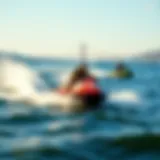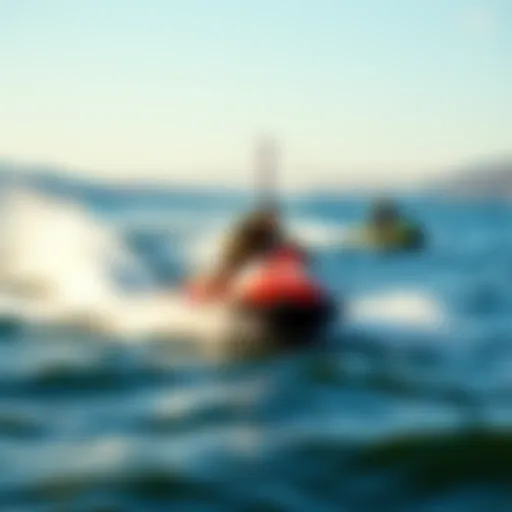Engine-Driven Paddle Boards: A New Era in Water Sports
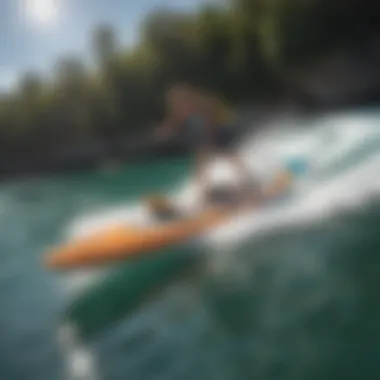

Intro
In recent years, water sports have seen a significant shift in equipment design. The introduction of engine-driven paddle boards represents a leap forward for both leisure users and competitive enthusiasts. These boards combine traditional paddling skills with cutting-edge technology, fundamentally changing the way people interact with water. There’s a substantial allure in combining physical exertion with the convenience provided by an engine. But what does this transformation mean for paddlers?
Essentially, it opens the door to a wider segment of individuals who may not have previously considered paddle boarding, be it due to physical limitations or interest in more leisurely experiences on the water. The potential for exploration and adventure expands exponentially with these innovative designs, making it worth examining the nuances of such a significant shift in the sport.
Essential Techniques
Paddling Techniques
Engine-driven paddle boards may diminish the need for extensive paddling skills, but understanding fundamental paddling techniques is still valuable. These techniques can help maintain stability and steer effectively, even when relying on an engine.
- Foot Placement: Position your feet shoulder-width apart to ensure balance.
- Core Engagement: Use your core for stability while you paddle, even if just for short bursts.
- Turning Techniques: Learn to use minimal paddling to turn without relying too much on the engine—sharp turns can be achieved with appropriate body positioning and paddle strokes.
Safety Practices
Navigating the waters on an engine-driven paddle board does introduce new safety considerations. While these boards offer speed and ease, the following practices can help ensure a safe experience:
- Wear a Personal Flotation Device (PFD): Always don a PFD to meet safety regulations and for your peace of mind.
- Know Your Surroundings: Stay aware of other boats or swimmers, especially in crowded waters.
- Check Engine Functionality: Regularly inspect the engine and battery life to avoid unexpected breakdowns.
As the saying goes, "An ounce of prevention is worth a pound of cure"—this rings especially true in water sports.
Gear Recommendations
Equipment Essentials
When it comes to gearing up for paddle boarding with an engine, some essential pieces can elevate your experience. Here's a pared-down list of must-have items:
- Engine-Driven Paddle Board: Choose a model that suits your intended use—speed or leisure.
- Paddle Board Leash: An often-overlooked safety item; it keeps you connected to your board.
- Waterproof Storage: Essential for protecting your belongings on the water.
Choosing the Right Gear
Finding the right equipment can be a daunting task, especially with the rapid advancements in technology. Here are some considerations:
- Determine Your Needs: Are you a casual paddler or looking for something robust for more demanding waters?
- Research Brands: Look into reputable brands that have established themselves in the engine-driven segment. Verify reviews and community feedback; platforms like Reddit can be valuable for real-world experiences.
- Test Before You Buy: If possible, try different models at a rental shop to see how they handle.
In summary, engine-driven paddle boards are reshaping the landscape of water sports. Through the exploration of techniques and gear, enthusiasts can enhance their experiences, catering to varied preferences and abilities of individuals on the water.
Prologue to Engine-Driven Paddle Boards
In the ever-evolving world of water sports, engine-driven paddle boards have emerged as a game changer. This innovation not only accentuates the thrill of gliding over water but also addresses concerns around accessibility and efficiency. The unique ability to combine traditional paddle boarding's charm with the speed and ease provided by an engine opens up a wide array of possibilities for both seasoned adventurers and novices alike.
Definition and Overview
Engine-driven paddle boards can be described as motorized vessels designed to navigate through water, integrating the stability of traditional paddle boards with propulsion systems powered by either gas or electric engines. Essentially, they allow users to maintain a steady pace without exhausting themselves physically. For many users, this is a compelling alternative to conventional paddling, particularly for those looking to explore larger waterways or tackle challenging distances. With a variety of designs available, from sleek racing boards to family-friendly versions, the market accommodates diverse user preferences, making these boards a versatile choice.
Historical Context
The concept of paddle boarding dates back to ancient times, with roots tracing to Polynesian cultures. However, the integration of engines into paddle boards is a relatively modern development, catalyzed by the growing interest in recreational boating and advancements in technology.
In the early 2000s, paddle boarding started gaining traction as a popular water sport, but it remained labor-intensive, relying heavily on physical effort. Fast forward to the last decade, as manufacturers began experimenting with engine designs, it became clear that there was demand for an easier, more accessible way to enjoy this timeless activity. Today, engine-driven paddle boards come equipped with various features such as remote controls and enhanced safety mechanisms, providing users with not just efficiency but also an unnerving sense of freedom on the water. This growth in popularity reflects a broader trend toward maximizing enjoyment and reducing the physical strain associated with recreational water activities.
"The blend of nostalgia from traditional paddle boarding with the excitement of new technology shapes the modern aquaculture landscape."
In summary, this section sets the stage for understanding the significance of engine-driven paddle boards in contemporary water sports. The following discussions will incapsulate the technological innovations driving this trend, the rising interest in prioritizing both performance and ease of use, and what the future holds for this remarkable pastime.
Technological Innovations in Paddle Board Design
Engine-driven paddle boards stand at the intersection of tradition and modernity, embodying the advancements in technology that have transformed recreational water activities. The significance of innovation in paddle board design is paramount; it determines not only the performance characteristics of the boards but also the overall user experience. This section delves into material choices and the types of engines used, alongside their specifications and how they contribute to enhanced enjoyment on the water.
Materials and Construction
Lightweight Composites
The inclusion of lightweight composites in paddle board construction is revolutionary. These materials, such as carbon fiber and foam core composites, provide a significant weight reduction over traditional materials. This feature allows for higher speeds and easier maneuverability, ideal for those who crave a dynamic surfing experience. The key characteristic of lightweight composites is their impressive strength-to-weight ratio, making them not only popular but crucial for performance.
A unique feature of these composites is their buoyancy, which ensures that despite their lower weight, the boards do not compromise on stability. Users can glide over water with minimal effort, enhancing the overall thrill of paddle boarding. Nevertheless, one must consider the trade-off; while lightweight composites can perform exceptionally well, they can be more expensive than conventional materials. Still, for many enthusiasts, the benefits far outweigh the costs, resulting in a demand that continues to grow.
Durability Considerations
When talking about durability, it’s essential to address how the materials used affect the lifespan and maintenance of paddle boards. Engine-driven models endure unique stresses that can undermine the integrity of the board. Using materials that resist wear and tear is fundamental in construction design. Regarded as a key characteristic, durability ensures that paddle boards withstand the rigors of the water, making them a favorable option for regular users.
One unique aspect of durability in modern paddle boards is the use of reinforced coatings, which protect against scratches and impacts. Enthusiasts appreciate that a durable board lasts for years with proper care, often reducing long-term costs. However, durability does come with a caveat: while tougher materials resist damage, they may sacrifice some flexibility. Ultimately, paddlers must weigh the pros and cons related to their personal preferences and usage patterns.
Engine Types and Specifications
Electric vs. Gasoline Engines
Let's look at engine types. The debate between electric and gasoline engines caters to divergent needs and preferences among paddle boarders. Electric engines often offer quieter operation and reduced emissions, making them a choice for ecologically-minded users seeking a cleaner experience on the water. This characteristic is particularly attractive for those who want to enjoy nature without disturbing its tranquility.
On the flip side, gasoline engines deliver superior power and range, appealing to adventurers looking to cover longer distances with greater speed. The unique feature here is the ability of gasoline engines to provide consistent performance, even on days when electric batteries trail off. However, gasoline engines introduce complexities such as fuel logistics and maintenance that can deter some users, presenting a clear choice depending on the paddler’s objectives.
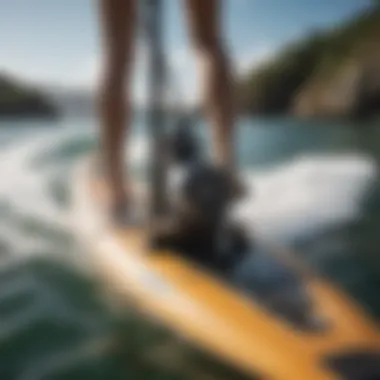

Power Output and Efficiency
Examining power output and efficiency reveals much about paddle board performance. Higher power output translates directly into speed and responsiveness. This makes it crucial for racers or those navigating challenging waters. The performance metrics of electric engines, especially, can vary significantly depending on technology, such as battery management systems that optimize energy use.
Moreover, the efficiency of an engine can dictate how long a user can remain on the water without needing to recharge or refuel. For instance, electric engines but demand less frequent maintenance and lower operational costs, with cleaner energy options also making them more appealing to a growing eco-conscious audience. However, battery life can be a disadvantage when compared to gasoline engines, which can refuel rapidly. Thus, paddle boarders must balance their desired speed and distance against the engine type, offering a layered discussion that enhances the engagement with the topic.
Ultimately, the choice of materials and engine technologies makes significant strides toward revolutionizing how we think about paddle boarding. Understanding each aspect not only enhances performance but also opens up numerous avenues for exploration in this rapidly evolving domain.
The next section will dive deeper into the advantages of choosing engine-driven paddle boards, as we delve into the myriad benefits they bring to both novice and seasoned enthusiasts.
Advantages of Using an Engine-Driven Paddle Board
When it comes to water sports, choosing the right equipment can make all the difference. Engine-driven paddle boards bring a unique spin to the traditional paddle-board experience. They offer distinct advantages that can enhance enjoyment on the water, making them increasingly popular among enthusiasts of assorted backgrounds. Understanding these benefits is essential for anyone looking to dive into the world of powered paddle boarding.
Increased Speed and Efficiency
Speed and efficiency stand out as two main benefits of employing an engine-driven paddle board. In the realm of water sports, these characteristics can significantly define one’s experience. With a powered board, users can zip across the surface rapidly, opening up the possibility for more extended exploration.
Traveling Longer Distances
Traveling longer distances is one of the most appealing aspects of engine-driven paddle boards. Imagine effortlessly gliding for miles without the fatigue of traditional paddling. This ability allows users to extend their journeys, reaching secluded beaches or hidden coves that may have previously felt inaccessible. The key characteristic here is range. An engine-driven paddle board affords each user the chance to venture farther, which is a notable advantage in any aquatic setting.
The unique feature of this capability lies in the power of the engine working to maintain higher speeds with less physical input. However, it should be noted that longer distances can also mean more energy consumption, which may be a concern for those who prioritize eco-friendliness. In general, engaging in longer excursions can immensely heighten the fun factor when compared with traditional paddling.
Minimizing Physical Effort
Minimizing physical effort is another undeniable advantage of using an engine-driven paddle board. For individuals who want to enjoy the water without the strenuous workout associated with traditional paddling, these powered boards provide a viable solution. This aspect is particularly beneficial for different demographics, including older adults or those recovering from injuries who might still enjoy being on the water.
The key characteristic in this instance is ease of use. Driven by an engine, users do not have to exert copious amounts of effort, making paddle boarding a more inclusive activity.
The drawback to consider here is that it could lessen the workout experience that many enthusiasts cherish. But still, many feel that the trade-off for relaxation and leisure is well worth it. In summary, minimizing physical effort presents a compelling reason to explore engine-driven options, making for a more enjoyable day on the water.
Accessibility for Diverse Users
Accessibility is another important aspect of engine-driven paddle boards. These boards cater to users from varying backgrounds and physical capabilities. With thoughtful adaptations, they can become a staple in recreational watersports, ensuring that no one misses out.
Adaptations for Mobility Impairments
Adaptations for mobility impairments allow broader participation in paddle boarding, emphasizing inclusivity. Engine-driven boards can be modified to come equipped with stability features or lower entry points, making them accessible for individuals with mobility challenges.
This aspect is a game-changer because it transforms paddle boarding from a niche activity to one that welcomes everyone. The key characteristic is the heightened support and stability offered by these adaptations, enabling users to enjoy the activity without fear of falling or struggling to stay afloat.
However, there is a need for further awareness and customization since not all boards come standard with these adaptations. Still, the advantages often outweigh the disadvantages, promoting more inclusive participation in this enjoyable pastime.
Family-Friendly Options
Family-friendly options are yet another critical advantage of engine-driven paddle boards. As families look to spend quality time together outdoors, these boards provide a practical solution for creating shared experiences on the water. Many boards now come with ample space to accommodate multiple riders or additional gear, making it easier to bring along kids or pets.
The key characteristic here is versatility—engine-driven paddle boards can efficiently cater to various family activities, whether that's fishing, exploring, or simply relaxing.
However, one should consider the age requirements for operating the engine and parental guidance might be necessary. Nonetheless, the unique features of family-friendly engine-driven paddle boards make them a popular choice for those looking to foster bonding moments in the serene surroundings of lakes or coastal areas.
Challenges of Engine-Driven Paddle Boards
The rise of engine-driven paddle boards has sparked excitement among water sports enthusiasts. Yet, it is crucial to delve into the challenges associated with these innovative crafts. Understanding these obstacles helps users make informed choices and enhances their overall experience on the water. From weight considerations to environmental impacts, the hurdles faced can inform design improvements and user practices.
Weight and Maneuverability Concerns
One prominent challenge with engine-driven paddle boards is their weight. Equipped with engines and fuel systems, these boards tend to be heavier than their traditional counterparts. This additional weight does not only affect transportation and setup but also plays a significant role in maneuverability.
When paddling in tight spots or navigating through rough waters, a heavier board can be quite the handful. Users may struggle to make quick turns or react promptly in challenging conditions. For seasoned paddlers familiar with the light gliding of standard boards, this difference could feel cumbersome.
Another point to consider is how the board's design impacts performance. Engine placement, weight distribution, and overall board stability can alter the riding experience. This makes it essential for manufacturers to strike a balance between engine capability and ease of handling. Paddle boarders might find themselves weighing their preference for power against the agility of lighter models, ultimately choosing what aligns with their specific interests.
Environmental Considerations
As we transition into oceanic activities that harmonize with nature, environmental effects come under significant scrutiny.
Sound Pollution
Sound pollution is one aspect that often gets sidelined when considering watercraft. Engine-driven paddle boards emit noise, which can disrupt marine ecosystems and affect wildlife behavior. Certain species of fish and birds are sensitive to noise, and disturbances can lead to altered migration patterns or loss of habitat. This is a critical consideration for those who appreciate the tranquility of nature while paddling.
The key characteristic of sound pollution in this context is its pervasive reach. Even though the engines might not produce a thunderous roar, the subtle hum can impact the serene ambiance that many paddle boarders cherish. To address this, some manufacturers are exploring quieter engine technologies or electric alternatives, which could allow users to glide through waters without disturbing the peace. The quiet hum of an electric motor could ensure that paddlers remain connected to nature, enjoying the sound of lapping waves and rustling leaves.
Fuel Emissions
Fuel emissions represent another significant environmental consideration. Gasoline-powered engines release pollutants that can contaminate water bodies, impacting aquatic life and ecosystems. This aspect of engine-driven paddle boards raises concerns about their sustainability in recreational use.
Fuel emissions contribute to a cycle of environmental degradation. Harmful chemicals can enter waterways, disrupting local ecology and potentially affecting human health. The unique feature here is the lingering impact of emissions, which pose long-term issues rather than immediate ones. Therefore, while the instant gratification of speed may entice some users, understanding the broader implications of their choices is essential.
Navigating the world of engine-driven paddle boards entails wrestling with these challenges. Before making a decision, potential users should consider factors like weight and environmental footprint carefully. Such considerations could lead to a more thoughtful and responsible park of this evolving sport.


Safety Considerations for Engine-Driven Paddle Boards
The realm of engine-driven paddle boards opens up exciting possibilities for adventurers and enthusiasts alike. However, safety must take center stage when embracing this innovation on the water. Understanding safety measures can drastically reduce risks and elevate the overall enjoyment. This section dives into critical aspects of safe paddling, ensuring both seasoned riders and newcomers tread thoughtfully on the waves.
Proper Usage Guidelines
Operational Training
Operational training is essential for anyone looking to command an engine-driven paddle board. Unlike a traditional paddle board, which relies solely on physical effort and balance, managing an engine demands a unique skill set. This training encompasses familiarization with the board's controls, understanding its handling characteristics, and mastering techniques for efficient navigation.
A well-designed operational training program is invaluable. A key characteristic of such programs is that they often involve practical exercises under supervision, allowing users to experience real-time reactions to engine responses. One major advantage is that trainees learn how to prevent accidents before any incidents occur.
Emergency Procedures
Emergency procedures are another critical component of safety that often gets overlooked. In the instance of an engine malfunction or unexpected weather changes, knowing how to react can make a significant difference. These procedures outline specific steps to take in various scenarios, such as losing power or encountering rough waters.
One notable feature of emergency protocols is their emphasis on quick thinking and clear communication among boarders. Learning these procedures prior to heading out not only prepares users but also instills confidence. However, a disadvantage lies in the fact that some procedures can be complex, making it challenging for beginners to absorb all that information at once.
Regulatory Compliance
Local Laws and Regulations
Navigating the legal waters is just as important as steering the paddle board itself. Local laws and regulations can vary, affecting everything from required safety equipment to specific polices on engine use. Familiarity with local regulations ensures compliance and helps avoid hefty fines or worse.
Understanding these laws often requires thorough research. A key characteristic of many regulations is that they promote safe practices on the water. This knowledge not only benefits the user but also contributes to the welfare of fellow paddlers and the environment.
For instance, some regions may mandate the use of personal flotation devices or restrict engine sizes. One advantage of regulations is that they provide a standard framework for safety, helping to ensure everyone on the water shares a concern for their wellbeing.
Licensing Requirements
Finally, licensing requirements can significantly impact who can operate an engine-driven paddle board. While some areas may not require a specific license, others do. Obtaining the necessary licenses often involves meeting age qualifications, passing tests, or demonstrating competence in operating the equipment.
The key characteristic here is that obtaining a license not only serves as a legal safeguard but also signifies that the operator has been educated on safe practices. This understanding is especially crucial in elevated safety.
However, these requirements can be burdensome for some. The disadvantage is that it may deter potential users who see licensing as an unnecessary hurdle rather than a safety measure. Nonetheless, it’s clear that comprehensive knowledge of safety and legal stipulations greatly enhances the paddle boarding experience.
Maintenance and Care for Engine-Driven Paddle Boards
Maintenance and care are essential for the longevity and performance of engine-driven paddle boards. Just as a car needs regular check-ups to ensure it runs smoothly, these paddle boards require attention too. After all, you don't want to be left high and dry on the water due to preventable issues. A well-maintained board not only enhances performance but also ensures safety while you’re out having fun on the waves.
Regular Maintenance Practices
Engine Checkups
One of the most critical aspects of maintaining an engine-powered paddle board is regular engine checkups. Just like a heart needs to be strong for overall health, the engine is the heartbeat of your paddle board. Over time, dirt and grime can build up, affecting performance. Regular checkups help in identifying and fixing issues before they snowball into something major. With the right checks, you're looking at enhanced fuel efficiency and possibly a longer lifespan for your engine.
- Key Characteristic: Ensures optimal engine performance.
- Unique Feature: Allows for early detection of potential issues.
What’s great is that most paddle board manufacturers provide specific guidelines for these checkups, so you're never steering in the dark. Ignoring these checkups might save time, but it could lead to hefty repairs—or worse—an accident on the water.
Board Inspection
Equally important is the inspection of the board itself. The hull, deck, and even the fittings can wear out or get damaged over time. Conducting regular inspections helps in spotting any weak points or damages, ensuring your board remains stable and safe for use.
- Key Characteristic: Prevents unexpected failures during use.
- Unique Feature: Involves checking for cracks, leaks, or cosmetic damages.
By maintaining a routine that includes checking for scratches or dents and repairing them promptly, users can save themselves a headache during outings. Remember, an ounce of prevention is worth a pound of cure.
Long-Term Storage Tips
When the season comes to an end, proper storage is crucial for the long life of your paddle board. Improper storage can lead to deformations or engine issues that could keep you off the water for longer than anticipated.
Seasonal Care
Taking care of your paddle board during off-seasons is all about being proactive. After any extensive use, make sure you clean the board thoroughly, especially if you've been in salt water. Seasonally cleaning also discourages mold or any unwanted growth.
- Key Characteristic: Keeps your board ready for immediate use when the next season rolls in.
- Unique Feature: Involves cleaning, drying, and inspecting for any wear.
Moreover, if you’re planning to store your board for weeks or months, consider dealing with the engine as well. Certain fluids can degrade over time, leading to performance dips when you finally decide to hit the water again.
Protective Covers
Using protective covers during storage can be a game-changer. These covers shield your paddle board from dust, UV rays, and the elements, which can greatly reduce the risk of damage.
- Key Characteristic: Offers a layer of security during periods of non-use.
- Unique Feature: Typically made of durable, weather-resistant materials.
Investing in a good-quality cover not only keeps your paddle board in excellent condition but can also save money in the long run by minimizing potential repairs due to environmental wear.
Comparative Analysis: Engine-Driven vs. Traditional Paddle Boards
When diving into the world of paddling, one can’t help but wonder how engine-driven paddle boards stack up against their traditional counterparts. This comparative analysis lays bare the important aspects of performance and cost implications, which aren’t just technicalities but rather the crux of choosing the right board for your watersport adventures.
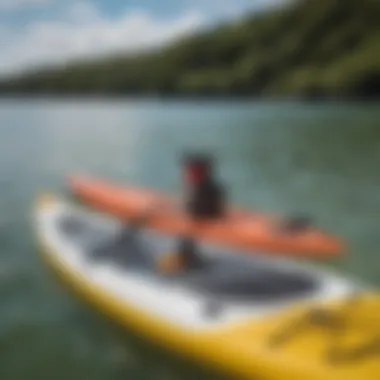

Performance Differences
Speed Metrics
One major angle in the performance debate is speed. Engine-driven paddle boards crank it up a notch compared to traditional designs, which rely solely on human effort. The presence of an engine transforms a leisurely paddle into a zippy experience, offering speeds that can be quite remarkable for open water exploration. For instance, while a seasoned paddler might manage 3 to 5 miles per hour on a traditional board, an engine-supported model can easily push those numbers to 12 miles per hour or more.
This significant increase in speed opens up new horizons. Imagine a quick getaway from the shore or rapidly navigating through lakes, rivers, or coastal areas. This added swiftness not only enhances the thrill but also allows adventurers to cover larger distances in a shorter timeframe. However, it’s worth noting that mastering these speeds requires some degree of proficiency in handling powered boards, making initial training essential.
Stability Factors
Stability is another vital factor worth considering. Traditional paddle boards are designed to provide a steady, balanced ride. Their buoyancy and shape are engineered for stability, making them ideal for paddling in calm waters. On the flip side, engine-driven boards can vary considerably in stability based on the engine's positioning and the overall design of the board. The key feature here is how these models manage weight distribution and balance when the engine is in use.
Some users report that engine-driven boards, particularly those with good design and the right components, can achieve impressive stability even at higher speeds. A wider base or a flat hull can mitigate issues related to tipping or wobbling, especially in choppy waters. Still, a poor design can lead to uncomfortable experiences or accidents, so players in the market for an engine-driven model must thoroughly research stability factors.
Cost Implications
Initial Investment
Switching gears, let’s discuss the cost of entry into this world. The initial investment for an engine-driven paddle board is often notably higher than that of a traditional paddle board. While a decent traditional paddle board can set you back anywhere from $500 to $2,000, engine-powered options usually begin around $1,500 and can go well above $5,000 depending on the make and model.
Why this significant price tag? Well, investing in advanced materials, the engine itself, and the technology that makes it all work does pile on the costs. Moreover, it’s important to remember the returns in terms of performance and capabilities can be very appealing, especially for those who plan to use the boards regularly.
Maintenance Costs
Maintenance costs also deserve a shout-out in this discussion. Engine-driven boards not only require regular check-ups of mechanical parts but may also need fuel, oil changes, and other upkeep not found with their non-powered counterparts. Traditional paddle boards typically involve little more than cleaning and storage considerations.
"While initial costs might be high for engine-driven boards, staying aware of maintenance can keep surprises at bay down the line."
When weighing the long-term journey, it’s crucial to factor in these maintenance costs so that you can get a complete picture of the overall investment.
In summary, the journey of comparing engine-driven paddle boards to traditional designs is multi-faceted. Performance aspects like speed and stability play a major role, while cost factors, including initial investment and potential maintenance demands, shape the decision-making process. For sports instructors and outdoor enthusiasts alike, understanding these elements provides valuable insights towards making informed choices.
The Future of Engine-Powered Paddle Boards
As the world of water sports continues to evolve, engine-powered paddle boards stand at the forefront of innovation. This emerging category is not just a passing fad; it angles toward reshaping how enthusiasts engage with water activities. The significance of this discussion lies in several key elements, such as technological advancements, market dynamics, and changing user preferences. Understanding the future can provide insights into the experiences that await both new users and seasoned aficionados alike.
Emerging Technologies
Advancements in Battery Technology
Battery technology is undergoing a transformation. Today, lithium-ion batteries are becoming the cornerstone of power for engine-driven paddle boards. These batteries are lightweight, durable, and can hold significantly more energy compared to older technologies. Their high energy density means that users can expect longer usage times without needing frequent recharges. Moreover, advancements in charging technology are reducing the downtime typically associated with electric-powered devices.
A unique feature of these batteries is their ability to fast charge. This is particularly advantageous on long trips where every moment counts. Imagine spending more time paddling rather than stuck at a charging station. However, keeping pace with rapid technological advancements can also bring challenges. For instance, while new batteries tend to be more efficient, they can sometimes come with a higher price tag, potentially limiting accessibility for some users.
Potential for Hybrid Models
The concept of hybrid models is gaining traction as paddle board manufacturers explore options that merge electric and traditional propulsion methods. These hybrid designs offer a dual advantage: they can harness the power of electric engines while still allowing for manual paddling. This means that users can enjoy increased range and versatility during their outings.
One key characteristic of hybrid models is the ability to switch between engine power and human power, depending on user preference or environmental conditions. For example, if the battery runs low, paddlers can continue their journey without worry. However, while they promise to be a groundbreaking solution, the added complexity of maintenance could deter some users from choosing such models. Additionally, the weight may be a concern, as hybrids might be bulkier than their purely electric or traditional counterparts.
Predicted Market Trends
User Adoption Rates
The excitement surrounding engine-powered paddle boards is reflected in the rising user adoption rates. With more individuals seeking easier, faster, and more fun ways to enjoy the outdoors, these boards are quickly becoming a popular choice. The simplicity of their use, coupled with advancements in design, makes them appealing even to those who might have hesitated before.
A major unique feature underlining this trend is the broad demographic appeal. Families, recreational users, and fitness enthusiasts are drawn to the versatility of engine-driven boards. Though there are benefits, market challenges remain. High costs and a learning curve in operating these boards can be hurdles that need overcoming for broader acceptance.
Impact on Recreational Watersports
Engine-powered paddle boards are set to reshape recreational watersports significantly. As they become more mainstream, we can expect a shift in how individuals and families approach water activities. Their faster speeds and ease of use will likely attract a new wave of enthusiasts, expanding the base of paddleboarding communities.
The unique element here is the potential for more entertaining experiences. With increased efficiency, users can explore previously unreachable waters, discover new locations, and participate in group activities that were less feasible with traditional boards. However, this shift also raises concerns around waterways becoming overcrowded, and if not managed properly, could lead to environmental implications. Balancing innovation with sustainability will be essential as this sport matures.
"The future is not something we enter. The future is something we create." – Leonard I. Sweet
Engine-powered paddle boards are more than just a trend; they mark the beginning of a new era in paddle boarding. As we look forward, it’s crucial for manufacturers, users, and regulators to collaborate to ensure the evolution takes place responsibly and sustainably, paving the way for both thrilling adventures and environmental stewardship.
Ending
In the expansive and constantly evolving world of water sports, engine-driven paddle boards signify an intriguing shift from traditional methods. This article has navigated through several key elements that make these powered boards an attractive option for enthusiasts of various skill levels. The core of the discussion revolves around advancements in technology, safety protocols, maintenance protocols, and varied implications for users. In essence, recognizing the importance of engine-driven paddle boards is vital as they offer an enhanced experience on the water with substantial benefits, while simultaneously presenting considerations that should not be overlooked.
Summary of Key Points
- Technological innovations in materials and engine efficiency have pushed boundaries, improving the durability and performance of paddle boards.
- The advantages of engine-driven boards, such as increased speed and the ability to cover longer distances, cater to a wide range of users, including those with mobility challenges and families seeking enjoyable experiences together.
- Environmental impacts must be considered, such as noise and fuel emissions, spurring a conversation around the need for more eco-friendly technologies in this sphere.
- Safety is paramount, with guidelines that should be well understood and adhered to by all users. Regulatory compliance ensures that all areas of usage are safe and legal.
- Lastly, the predicted evolution of technologies, including advancements in battery performance and possible hybrids, hint toward a future where engine-driven paddle boards could become mainstream, shaping recreational watersports in unprecedented ways.
Final Thoughts on Future Innovations
As the water sports arena continues to embrace new technologies, the future of engine-driven paddle boards looks promising. Innovations like light-weight materials and more efficient engines will not only enhance performance but also improve safety and environmental aspects of paddleboarding.
- Potential developments include hybrid models that balance engine power with human paddle input, allowing for a tailored experience.
- The growing interest in eco-friendly designs may significantly influence users' decisions, promoting sustainability while enjoying water activities.
- Market trends suggest an uptick in user adoption, as more individuals and families look for ways to connect with nature in an effortless yet exhilarating manner.
The journey into engine-driven paddle boards has only just begun, and as technology progresses, the possibilities seem limitless. Embracing this evolution means engaging with a broader community of water sports enthusiasts who appreciate the fusion of tradition with innovation.
"In the world of paddle boarding, adapting to change is just as crucial as mastering the basics. Engine-driven boards invite both seasoned veterans and novices to explore new horizons in their aquatic adventures." - Unknown
Understanding the nuances of these developments fosters not just enjoyment on the water but a culture of safety, respect for nature, and passion for the sport. This balance may well determine the success of engine-driven paddle boards in the years ahead.


